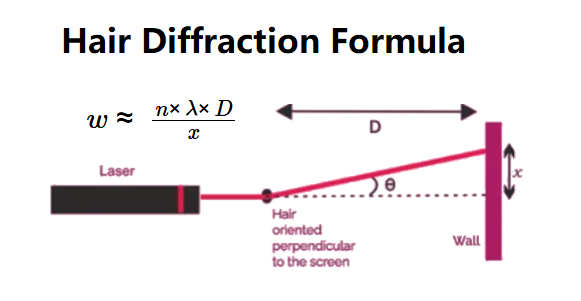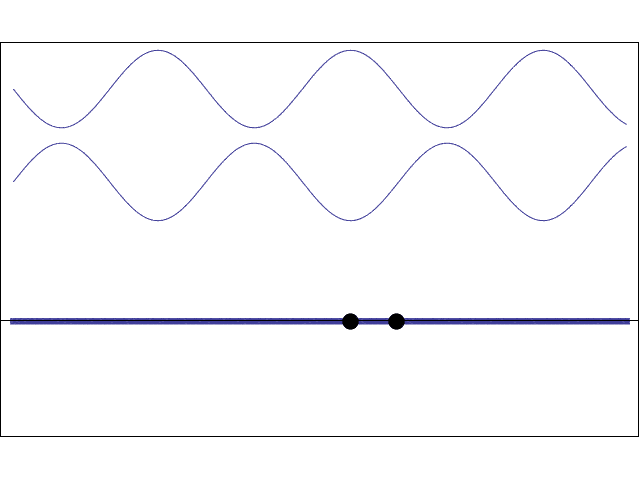1. What is the Hair Diffraction Calculator?
Definition: This calculator uses the diffraction formula for a single slit (approximated by a hair) to compute the width of the hair (\( w \)) and the diffraction angle (\( \theta \)) based on the position of the dark point (\( n \)), the wavelength of the light (\( \lambda \)), the distance from the hair to the screen (\( D \)), and the distance from the center of the diffraction pattern to the dark spot (\( x \)).
Purpose: It is used in optics to estimate the width of a thin object (like a hair) by observing its diffraction pattern, demonstrating the wave nature of light and the principles of single-slit diffraction.
2. How Does the Calculator Work?
The calculator uses the following equations:
- \( w \approx \frac{n \times \lambda \times D}{x} \)
- \( \theta \approx \frac{x}{D} \quad (\text{small-angle approximation, in radians}) \)
Where:
- \( n \): Position of the dark point (integer, typically \( n = 1 \));
- \( \lambda \): Wavelength of light (m, nm, pm, µm, Å, in, ft, yard, converted to m);
- \( D \): Distance from hair to screen (m, cm, mm, in, ft, yard, converted to m);
- \( x \): Distance from the center of the diffraction pattern to the dark spot (m, cm, mm, in, ft, yard, converted to m);
- \( w \): Width of the hair (m, µm, mm);
- \( \theta \): Diffraction angle (degrees or radians).
Steps:
- Enter the position of the dark point (\( n \)).
- Enter the wavelength (\( \lambda \)) with its unit.
- Enter the distance from the hair to the screen (\( D \)) with its unit.
- Enter the distance from the center of the diffraction pattern to the dark spot (\( x \)) with its unit.
- Convert the wavelength, distance \( D \), and distance \( x \) to meters.
- Calculate the hair width: \( w \approx \frac{n \times \lambda \times D}{x} \).
- Calculate the diffraction angle: \( \theta \approx \frac{x}{D} \) (in radians).
- Convert the angle to degrees if selected, and the hair width to the chosen output unit.
- Display the results, formatted in scientific notation if the absolute value is less than 0.001, otherwise with 4 decimal places.
3. Importance of Hair Diffraction Calculation
Calculating the hair width and diffraction angle is important for:
- Optics Education: Demonstrating the principles of single-slit diffraction and the wave nature of light using a simple experiment.
- Experimental Physics: Measuring the dimensions of thin objects (like hairs or wires) using diffraction patterns.
- Interdisciplinary Applications: Understanding diffraction in biological systems (e.g., hair or fibers) and optical instruments.
4. Using the Calculator
Example 1: Calculate the hair width and diffraction angle using a red laser with the new units:
- Position of Dark Point: \( n = 1 \);
- Wavelength: \( \lambda = 650 \, \text{nm} = 6.5 \times 10^{-7} \, \text{m} \);
- Distance from Hair to Screen: \( D = 1 \, \text{yard} = 0.9144 \, \text{m} \);
- Distance to Dark Spot: \( x = 1 \, \text{in} = 0.0254 \, \text{m} \);
- Hair Width: \( w \approx \frac{1 \times 6.5 \times 10^{-7} \times 0.9144}{0.0254} \approx 2.34 \times 10^{-5} \, \text{m} = 23.4 \, \text{µm} \);
- Diffraction Angle: \( \theta \approx \frac{0.0254}{0.9144} \approx 0.0278 \, \text{rad} \approx 1.591 \, \text{°} \);
- Result: \( w = 23.4000 \, \text{µm} \), \( \theta = 1.5910 \, \text{°} \).
Example 2: Calculate the hair width and diffraction angle using a green laser with the new units:
- Position of Dark Point: \( n = 1 \);
- Wavelength: \( \lambda = 532 \, \text{pm} = 5.32 \times 10^{-10} \, \text{m} \);
- Distance from Hair to Screen: \( D = 2 \, \text{ft} = 0.6096 \, \text{m} \);
- Distance to Dark Spot: \( x = 5 \, \text{mm} = 0.005 \, \text{m} \);
- Hair Width: \( w \approx \frac{1 \times 5.32 \times 10^{-10} \times 0.6096}{0.005} \approx 6.484 \times 10^{-8} \, \text{m} = 0.0648 \, \text{µm} \);
- Diffraction Angle: \( \theta \approx \frac{0.005}{0.6096} \approx 0.0082 \, \text{rad} \approx 0.470 \, \text{°} \);
- Result: \( w = 0.0648 \, \text{µm} \), \( \theta = 0.4700 \, \text{°} \).
5. Frequently Asked Questions (FAQ)
Q: What does the hair diffraction calculation tell us?
A: It allows us to estimate the width of a thin object (like a hair) by observing the diffraction pattern it creates when light passes through it, and it provides the angle at which the dark fringe appears, illustrating the wave nature of light.
Q: Why is the small-angle approximation used?
A: The distance from the hair to the screen (\( D \)) is typically much larger than the distance to the dark spot (\( x \)), making the diffraction angle (\( \theta \)) very small. For small angles, \( \sin(\theta) \approx \theta \), simplifying the calculation.
Q: Can this calculator be used for objects other than hair?
A: Yes, it can be used for any thin object (e.g., a wire or slit) that acts as a single slit for diffraction, as long as the diffraction pattern is observable and the small-angle approximation holds.
Hair Diffraction Calculator© - All Rights Reserved 2025
 Home
Home
 Back
Back

